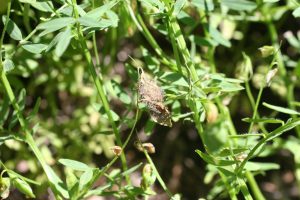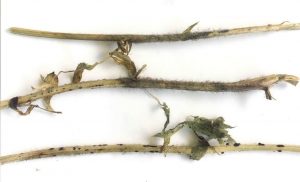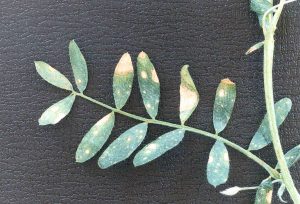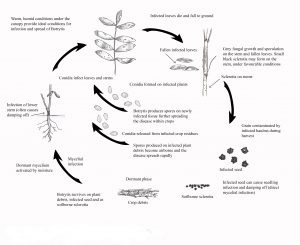Botrytis grey mould of lentil is a foliar disease caused by the fungal pathogens Botrytis cinerea and Botrytis fabae. Botrytis grey mould (BGM) has been reported in many lentil growing countries of Asia and throughout North America but appears to be more severe in Australia.
What to Look For
The disease can infect all above ground parts of the lentil plant, including leaves, stems and pods. The first symptoms are discrete greyish-brown lesions on the lower leaves of the plant. However, no black fruiting bodies are produced within the lesions.
Infected leaves can become covered with a fuzzy layer of grey mould toward the base of the plant.
Stem lesions will appear light brown or bleached and can be covered in grey, mouldy growth.
The mouldy growth consists of spore masses that can quickly spread to infect surrounding plants. Clouds of spores can rise from infected plants if they are disturbed. Dark black fungal survival bodies, known as sclerotia, can develop on stems and it is these structures that survive over summer on lentil stubble. Severely infected leaves, flowers and pods wilt and fall to the ground. Plants ripen prematurely due to infection of the lower stem. If conditions remain wet throughout spring, stems can become girdled and patches of brown dying plants appear in the crop.

Patches of dying lentil plants at a trial site in South Australia in 2005. (Photo courtesy of Kurt Lindbeck – NSW DPI).
Infected pods will fail to fill properly and will produce shrivelled seed or no seed at all. Infected seed is discoloured.

Lentil pod with symptoms of BGM. Note the typical dark grey, fuzzy growth of the fungus (Photo courtesy of Kurt Lindbeck – NSW DPI)
Disease Cycle
The disease inoculum readily survives on alternate hosts such as faba bean (Botrytis fabae) and chickpea (Botrytis cinerea), which are also grown in close rotation with lentil. The pathogens can survive on stubble residue (lentil, chickpea or faba bean) or in the soil as sclerotia but can also be carried on infected seed. When seed infected by these fungi are sown seedling blight will occur soon after crop emergence, reducing plant populations. Masses of spores are produced on infected plants which can then spread onto surrounding plants by wind and rain-splash to begin new infections.
Symptoms of grey mould appear more commonly in early spring following canopy closure. Dense crop canopies combined with warm, wet conditions in late winter and early spring favour development and spread of the disease. Often symptoms of BGM first appear in double sown areas of the crop. Moisture within the crop canopy is essential for infection. Lentil crops sown early and/or at high seeding rates appear to be the worst affected by BGM. The disease usually starts off affecting lower leaves and the base of the stem. Prolonged wet conditions during the growing season can cause the disease to progress higher up the plant, subsequently affecting pods.
Management
Use Clean Seed
Only use seed with less than 5 per cent botrytis infection; ideally use seed with nil infection. Using old or damaged seed can reduce seedling vigour and increase susceptibility to infection. See Seed Health Testing in Pulse Crops (AG1250) for more information.
Varietal Resistance
Use varieties with greater resistance to botrytis grey mould. Warning – all varieties are susceptible to grey mould in areas and years where disease pressure is high.
Paddock Selection
Avoid planting this season’s crop near old lentil, faba bean, chickpea, vetch or lathyrus stubble. These crop residues can harbour Botrytis fabae or Botrytis cinerea. A program of stubble reduction may also be undertaken by grazing or burying to reduce the carryover of infected stubble into the following season. Allow a break of at least 3 years between lentil crops.
Seed Treatment
Use a registered seed treatment for the control of seed-borne diseases of lentil. Seed treatments can have a deleterious effect on rhizobia. Therefore, seed should be treated with fungicide and then inoculated with rhizobia in two separate operations. Rhizobia should be applied to seed immediately before sowing, especially on acid soils.
Sowing
Sow later and reduce seeding rates. Early sowing and high sowing rates can cause rank crop growth, lodging and increased risk of grey mould. Follow the recommended sowing rates and sowing dates for your district.
Use Foliar Fungicides
In areas of high risk it may be necessary to apply foliar fungicides to protect the crop, especially if a susceptible variety is being grown. Fungicides should be applied before canopy closure for best results. If conducive (warm and wet) conditions continue, follow up sprays may be necessary 12-14 days later.
There are a range of fungicides available to control BGM and selection of the most appropriate fungicide could depend on the level of disease pressure present. Fungicides containing mancozeb, chlorothalonil, carbendazim, or procymidone have activity against Botrytis spp. If disease pressure is high then carbendazim or procymidone are the preferred fungicides. It is worth noting that these products are protectants and are most effective if applied before disease development.





